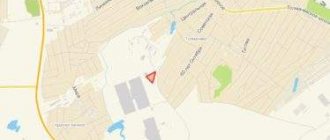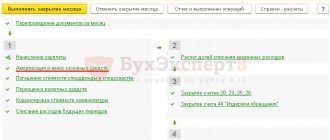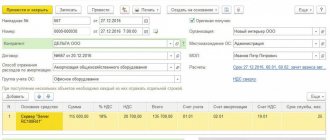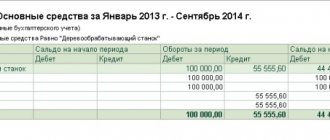What is OS
The concept of fixed assets is disclosed by PBU 6/01 “Accounting for fixed assets” and the Tax Code of the Russian Federation. OS is the property of an enterprise, repeatedly used in production and economic activity, meeting the conditions:
- intended for long-term use (more than a year);
- not for sale;
- not processed during the production process (like raw materials);
- it is expected to make a profit.
In other words, OS are buildings, equipment, machines, machines, computers, office equipment, household supplies, etc. OS also include animals, fruit-bearing perennial plants, capital communication and transport facilities (communication centers, roads, power grids).
The criteria for fixed assets also include the initial cost, but it is different for accounting and tax accounting. In accounting (BU) (clause 5 of PBU 6/01), the maximum cost of classifying property as MPZ is 40,000 rubles. (accounting policy may establish a smaller amount). Such property is written off as expenses as soon as it is put into production. Anything that exceeds this limit, but meets the above criteria, is taken into account as OS.
ATTENTION! From 2022, the new FSB 6/2020 “Fixed Assets” and FSB 26/2020 “Capital Investments” are mandatory. The provisions of these standards can be applied earlier by prescribing such a decision in the accounting policies of the enterprise.
ConsultantPlus experts explained step by step how to disclose information in reporting when applying FAS 6/2020 “Fixed Assets” and FAS 26/2020 “Capital Investments”. Get free demo access to K+ and go to the ready-made solution to find out all the details of this procedure.
In tax accounting (TA) objects worth up to 100,000 rubles. inclusive, are not considered fixed assets (Article 257 of the Tax Code of the Russian Federation). The assignment of an asset to fixed assets affects the procedure for accounting for its value as part of expenses (fixed assets are subject to depreciation, i.e., they are written off gradually according to the accounting policy of the enterprise, and inventories are written off at a time), as well as the procedure for document flow, inventory and write-off.
Contribution of fixed assets to the authorized capital of another organization
Fixed assets are sometimes used by enterprises as financial investments, investments in other legal entities.
Example 3
PE "Perspektiva" is registered as a participant in LLC "Sokol". The charter of the LLC stipulates that the private enterprise “Perspektiva” makes a contribution to the authorized capital, estimated by the meeting of participants at three hundred thousand rubles, to a vegetable processing line. The line was transferred to the LLC with the appropriate execution of the acceptance certificate and other documents.
Previously, it was operated on the balance sheet of a private enterprise. Its book value is 280,000 rubles, accumulated depreciation in the amount of 30,000 rubles.
Accounting entries:
Dt02 Kt01/2 - 30,000 rubles (for the amount of accrued depreciation);
Dt58/1 “Financial investments” Kt01/2 - 250,000 rubles (for the amount of residual value);
Dt19 Kt68 - 56,000 rub. (VAT reflected when purchasing the line is restored);
Dt58/1 Kt19 - 56,000 rub.;
Dt91/2 Kt58/1 — 6000 rub. (displayed as part of other expenses is the amount of loss from the operation of the investment line: The cost of the share in the authorized capital is 300,000 rubles - the residual value is 250,000 rubles - the amount of restored VAT on acquisition is 56,000 rubles).
Postings upon receipt of fixed assets
Fixed assets are taken into account at their original cost. It is understood as the sum of the cost of purchasing the OS and other expenses associated with this purchase (installation, delivery, customs duties, intermediary commission, etc.).
IMPORTANT! The initial cost of an asset does not include VAT if this tax is refundable for the company (clause 8 of PBU 6/01). Non-payers of VAT (for example, simplifiers) take this tax into account in the initial cost of property (subclause 3, clause 2, article 170 of the Tax Code of the Russian Federation).
The OS is accepted for accounting on the date when it is fully formed, and for NU - when the OS is put into operation.
When an asset is received, accounting records are generated:
- Dt 08 Kt 60 (10, 70, 69) - expenses for the acquisition or creation of fixed assets are taken into account;
- Dt 19 Kt 60 - input VAT is allocated;
- Dt 01 Kt 08 - PS OS was formed.
For information on how to account for VAT on fixed assets, read the article “How to claim VAT on fixed assets or equipment for deduction.”
If the OS requires installation, then account 07 “Equipment for installation” will be included in the postings. As a rule, it is used by construction organizations. The account accumulates information about equipment that requires technological installation, connection to networks and communications and is intended for installation in premises under construction. After the costs are fully collected on the account, the amount of the installed OS is written off to Dt account 08 (Dt 08 Kt 07). Next, the same algorithm is applied: amounts from account 08 are written off to account 01, thus forming the initial cost of the asset.
More detailed information is provided in the Guide to the purchase and sale of real estate from ConsultantPlus. Get free trial access to the system and proceed to the materials.
Accounting for depreciation of fixed assets: postings
Unlike materials and inventories consumed in production, fixed assets transfer their cost to company expenses gradually. This process is called depreciation. However, it is not accrued for certain types of fixed assets. Such objects include assets that do not change production qualities during the operation of the enterprise: land plots, cultural heritage sites, art collections, etc.
In accounting, four methods of calculating depreciation are used (linear, reducing balance method, by the sum of the numbers of years of useful life, in proportion to the volume of production), however, for the purposes of accounting, only linear and non-linear methods are used.
IMPORTANT! As a rule, an organization uses one method of calculating depreciation for accounting and financial accounting, since different methods create tax differences that require additional attention of an accountant. Therefore, the linear calculation method is usually used.
Linear depreciation is calculated using the formula:
A = PS / SPS,
Where:
A is the monthly depreciation amount;
PS - initial cost of fixed assets (account balance 01);
SPS is the useful life of the OS.
To calculate it, you need to know the useful life of the asset, established by the Decree of the Government of the Russian Federation “On the classification of fixed assets included in depreciation groups” dated January 1, 2012 No. 1. In accounting, fixed assets can be written off faster than in tax accounting, using other calculation methods and a shorter period of use, but then tax differences are formed, since accounting and tax amounts will differ.
An example of calculating depreciation using the straight-line method was prepared by ConsultantPlus experts. Get trial access to the system for free and proceed to the example.
To account for depreciation, records are kept in account 02 “Depreciation of fixed assets.” Its amounts are debited from the accounts of production and commercial costs (20, 23, 25, 26, 29, 44), forming a credit balance on account 02.
The accountant creates monthly records:
Dt 20 (23, 25, 26, 29, 44) Kt 02 - depreciation has been accrued for fixed assets.
Accounting for write-off of fixed assets upon wear and tear
A sad moment comes when the main asset becomes unusable and can no longer be used for its intended purpose. This fact can be revealed by enterprise employees during operation or during an annual inventory.
Write-off of a separate unit of fixed assets is carried out on the basis of a standard Write-off Certificate (Form OS-4) , for vehicles OS-4a. The write-off commission determines and reflects in the act the property - scrap metal, spare parts, materials that can be used in the future in production activities or sold externally.
Example 2
During the inventory process, it was revealed that the sawing table had fallen into disrepair and was to be written off. Its original cost is 20,000 rubles, depreciation has been charged in the amount of 18,000 rubles. The company's workers dismantled and disassembled it. Disassembly costs amounted to 250 rubles. After dismantling, spare parts worth 1200 rubles and materials worth 500 rubles were credited to the warehouse. and scrap metal worth 600 rubles.
The following entries must be made in accounting:
Dt01/2 Kt01 — 20,000 rub.
Dt02 Kt01 — 18,000 rub.
Dt91/2 Kt01 — 2000 rub. (for the amount of residual value of 20,000 rubles - 18,000 rubles).
Dt91/2 Kt23.25 - 250 rub. (disassembly costs).
Dt10 Kt91/1 — 1100 rub. (recorded materials and scrap metal are registered and displayed as other income).
Dt10/5 Kt91/1 - 1200 rubles (spare parts are capitalized).
Accounting entries for the restoration of fixed assets
The initial cost may increase if work is carried out to restore the OS (modernization, reconstruction and retrofitting). The accounting procedure for such operations differs depending on whose forces this modernization is carried out: a third-party organization or independently. If the modernization is carried out by a third-party contractor, then the costs of such work are reflected in Dt account 08 in correspondence with account 60 “Settlements with suppliers and contractors”. In this case, the postings are generated:
- Dt 08 Kt 60 - reflects the cost of the contractor’s work;
- Dt 19 Kt 60 - VAT allocated.
If the work is carried out independently, then the costs of additional equipment are taken into account on account 08 in correspondence with the cost accounts (10, 70, 69, etc.). This creates the following records:
Dt 08 Kt 10 (70, 69, etc.) - reflects the costs of upgrading the OS.
Upon completion of the work, the amounts accumulated on account 08 are written off to account 01 Dt, thus increasing the initial cost of the asset.
Read more about the features of accounting and NU OS in the article “Modernization of fixed assets - accounting and tax accounting.”
OS sales
In the case when an organization sells fixed assets, it is obliged to record the cost of sale of the asset and the original cost minus depreciation (residual value). Records are generated:
- Dt 62 Kt 91 - income from sale is recognized;
- Dt 91 Kt 68 - VAT reflected;
- Dt 02 Kt 01 - depreciation written off;
- Dt 91 Kt 01—residual value written off.
Ownership of the asset is transferred on the basis of a deed (Form No. OS-1). If the object of sale is real estate, then the date of transfer of rights is the date of state registration.
Postings in case of liquidation and shortage of OS
There are cases when it is no longer practical to use the OS, and selling it is not an economically profitable enterprise. In this case, we are talking about writing off the fixed assets on the basis of a write-off act drawn up by the organization. In order to avoid claims from the tax authorities, it is necessary to draw up correct and substantiated documents for writing off fixed assets. In this article we will not dwell on this.
Postings upon liquidation will be as follows:
In addition, during inventory, a shortage of OS may be detected:
So, when writing off fixed assets that are still subject to depreciation, the postings will be uniform, regardless of the reasons and order of write-off. Let's highlight them:
- the original cost of the fixed asset item was written off - posting Dt 01.09 Kt 01.01;
- write-off of depreciation of fixed assets - posting Dt 02.01 Kt 01.09;
- write-off of the residual value of fixed assets - posting Dt 91.02 (and others) Kt 01.09.
Postings for write-off of fixed assets in 1C 8.3 must be made as follows:
Results
Thus, asset accounting is quite diverse, as it accompanies many situations related to the acquisition, use, write-off, and modernization. Acceptance of an asset for accounting (account 01) occurs through accounts 07 and 08, which accumulate expenses associated with acquisition, installation, delivery, etc. Disposal of fixed assets occurs by writing off the residual value for other expenses of the organization.
Sources: Tax Code of the Russian Federation
You can find more complete information on the topic in ConsultantPlus. Free trial access to the system for 2 days.




